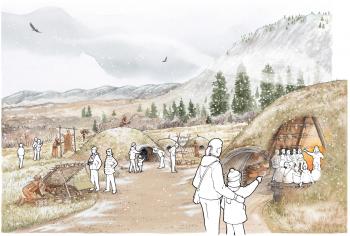Image Caption
Summary
Local Journalism Initiative Reporter
Windspeaker.com
The First People’s Cultural Council (FPCC) has received a grant in the amount of $4 million to help First Nations in BC create or revamp cultural heritage projects in their communities.
Of 104 proposals submitted to FPCC in total, they selected 11 that will receive funding of up to $400,000 each.
All projects needed to be “shovel-ready” which means construction will start right away. Funding is for three-years beginning this March.
“As we all continue to move forward together towards meaningful equitable partnerships, our goal is that Indigenous peoples will be recognized as the rightful authority over their cultural heritage with access to sustained funding to carry out this work,” said Karen Aird, Heritage Program Manager for FPCC.
“We know there is tremendous need and opportunity from First Nations to revitalize their Indigenous cultural heritage, while also creating jobs and boosting the economy of our province at the same time,” she said.
One of the projects receiving funding is the Fort Nelson First Nation’s Chalo Traditional Trades and Cultural Education Centre, which will receive $400,000.
“A lot of the traditional language and culture practices are still alive and well in the community, but not as prominent as have been in other generations,” said Lana Lowe, director of lands, resources and Treaty rights for the Nation.
“This project is a really big piece of it because we need a place to bring meat and hides, and a place central on reserve where people can come and see the work in progress and possibly join in if they feel like it,” she said.
According to Lowe, something like a museum would have been a “non-Dene” way of sharing culture. Their project includes a “trading post,” instead, where community members can display and even sell (if they choose to) “furs and hides and baskets and moccasins” they make, she said.
“I think that’s really, really important because that trading piece will help support the re-establishment of our traditional economy that supported our families for generations,” said Lowe.
The existing Chalo adult trade centre will see major upgrades to turn it into this new cultural education centre.
The upgrades are:
- Having Elders mentor community members who want to learn about traditional practices;
- building outdoor moose camp facilities for meat processing, like dry meat racks, a smoke shack, and hide frames;
- adding indoor stainless steel tables for meat processing in colder months, and a meat cooler where community members can store meat for a day before processing it;
- upgrading electrical plumbing and repairs on the roof;
- computer upgrades so community members can access FPCC’s own First Voices archive, an online Indigenous language tool.
“It provides support where people can go out on the land to hunt, to fish, to collect medicines, and do all those things… And process meat and materials that come off the land, and turn it into something really beautiful,” said Lowe.
And they’re considering naming the facility after a beloved Elder in the community who recently passed away; a traditional language teacher of more than 20 years, she said. But the vote on that has yet to happen.
The FPCC funding is called the Indigenous Cultural Heritage Infrastructure Grant (ICHIG) which comes through the Unique Heritage Infrastructure (UHI) stream from the Ministry of Forests, Lands, Natural Resource Operations and Rural Development.
Sixteen million dollars was given to Heritage BC under the same stream, which First Nations—including the communities and organizations that received funding through FPCC’s ICIHG—can also apply for, according to Aird.
FPCC would have needed more than $45 million in total to fund all the projects they received proposals for, she said. But this is a good start, she added.
“Investing in these heritage and cultural projects supports Indigenous efforts to maintain and share their culture across B.C.,” said Katrine Conroy, minister of Forests, Lands, Natural Resource Operations and Rural Development.
“Projects like these are especially important as they celebrate aspects of culture that make us different while bringing us together as British Columbians. They also provide economic opportunities for First Nations communities,” said Conroy.
The other successful ICHIG applicants were:
- Alert Bay’s U’mista Cultural Society which will receive $294,000 for upgrades to their existing cultural centre;
- Bella Bella’s Kunsoot Wellness Society which will receive $400,000 for construction of new infrastructure at their existing health centre;
- the Nk’Mip Desert Heritage Society in Osoyoos which will receive $400,000 for construction of a traditional pit house;
- the Tse’k’wa Heritage Society in Fort St-John which will $379,337 for upgrades to their Tse’k’wa Cultural Heritage Centre;
- the Tk’emlups te Secwepemc in Kamloops that will receive $259,207 for upgrades to museum HVAC and electrical wiring;
- the Dzawada’enux First Nation in Kingcombe Inlet which will receive $135,660 for Traditional Bighouse restoration;
- the Nisga’a Lisims Government in New Aiyansh that will receive $377,293 for upgrades to archival storage and HVAC systems at their Nisga'a Museum: Safeguarding the Ancestors Collection;
- the Haida Gwaii Museum Society in Skidegate who will receive $399,603 for upgrades and repairs at their Saahlinda Naay – Saving Things House: Museum;
- the Ucluelet First Nation which will receive $400,000 for construction of a facility to house artifacts at their Yuułuʔiłʔatḥ Cultural Center;
- and the Ehattesaht Chinehkint Tribe in Zeballos whish will receive $304,500 for construction of an outdoor gathering space for transmission of traditional knowledge, called the Wisdom Bench – nawaayisim.
The UHI falls under the larger $100 million the province set aside for the Community Economic Recovery Infrastructure Program (CERIP), and is largely intended to help with recovery from the impact of COVID-19. https://www2.gov.bc.ca/gov/content/economic-recovery/cerip
Local Journalism Initiative Reporters are supported by a financial contribution made by the Government of Canada.

